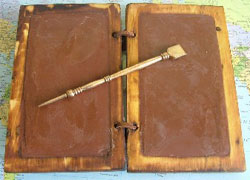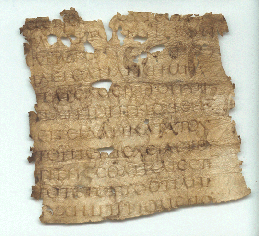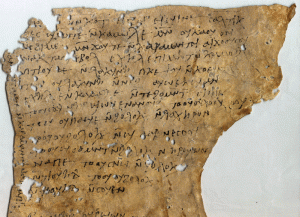Materials:
The Letters of Ancient Rome were mainly written on four materials: wax tablets, parchment, animal skins, and papyrus. Wax tablets had wooden or bronze frames where melted beeswax was poured into. A metal or wooden stylus was then used to carve messages into the dried wax. In Britain in the 1970’s, another type of tablet was discovered. This tablet was a thinly sliced board of wood written on with ink. Papyrus is a thin paper made from the papyrus plant that was also written on with ink. Parchment was a thicker paper, and dried animal skins was obviously the thickest form of a letter base, both were either written on with ink or carved into.



Wax Tablet Parchment Animal Skin
Intent:
There are numerous reason why Romans would write letters to one another; including love, business, philosophizing and just as a formality of friendship. Love letters were exchanged between a man and his wife or even a man and his mistress. Business letters were written to complete transactions and used as a type of receipt. Letters of advice were written to help friends and acquaintances through tough times. Philosophical letters served as debate topics and raised thoughtful and intellectual questions. Letters were also considered a “formality of friendship” to keep friends and family members in touch, like texts and phone calls today.
Structure:
All Roman letters have a strict structure to them. Each letter has an opening, a message, and a conclusion. Roman letters are very similar to five paragraph essays that students today write ad nauseam.
The opening of a letter is like the introductory paragraph of an essay. It would have a varying tone depending on who the letter was intended for (see previous post), but generally the letter would open with the author’s name at the top (nominative case) and the addressee’s name below (dative case). A greeting such as “salutem dicit” would start the body of the letter, followed by an inquiry about the welfare of the receiver.
The message of a letter is like the “meat” of a five paragraph essay. The length of the message can be as short as a sentence or as long as the writer wants.
The conclusion of a letter, like the concluding paragraph of an essay,sums up the letter. The writer signs off, and concludes with a form of “vale” (bye, farewell, etc.).
Style:
Typically, a letter is a piece of writing with specific traits. These traits include a restricted length (not enforced), a particular addressee (or recipient) and a preoccupation with friendship or acquaintance, and a writer. A letter written in the epistolary form, is a letter in which the writer incorporates a piece of writing such as a poem into it. The ancient Greek writer Demetrius was the first person to begin the tradition of writing analytic letters; as discussed in is book titled, De Electione, or in English, ‘On Style‘.
To see an example of a Latin letter, click here or here
To see my product, click here
Works Cited
Britanniae, Brittany. "How to Write a Love Letter in Latin." Latin Language Blog. Transparent Language, 11 June 2014. Web. 11 Dec. 2014.
Clackson, James. "A Companion to the Latin Language." Epistolary Latin (2011): n. pag. Blackwell. Web. 11 Dec. 2014.
Ferrante, Joan M. "Speculum." Dear Sister: Medieval Women and the Epistolary Genre 70.2 (1995): 352-54. JSTOR. Web. 11 Dec. 2014.
Jahnige, Joan. "Epistolary Writing in Roma Antiqua." Roman Culture. KET, Jan. 1998. Web. 11 Dec. 2014.
Piazza, John, Magister. "How to Write a Latin Letter." Magister Ioannes Piazza. N.p., 2005. Web. 11 Dec. 2014.
Trapp, Michael. "Greek and Latin Letters: An Anthology with Translation." Letter-Writers, Their Works, and Contexts (2003): n. pag. Cambridge University Press. Web. 11 Dec. 2014.
I think the comparisons that can be made between the content of the Roman letters and the content of emails, texts, and philosophical tweets that are made today are very interesting. It shows that we are still interested by the same concepts the Romans were; however, our expression of these concepts has changed over time.
ReplyDeleteI disagree with Yash's comment that we are still interested in the same concepts the Romans were. I believe that as a society, we are losing that communication that the Roman's valued. In this day and age, a hand written letter, signed, sealed, and delivered is as rare as dinosaurs. The content of our lackadaisical emails and half-hearted text messages does not deliver the same content that the Roman's strived for. It is not that, we are less involved. I believe that the issue is that people are too focused on efficiency. A hand written letter could take an hour. A text message takes maybe a minute. The value comes with time and effort, something we have lost.
ReplyDeleteThe comparison between a typical letter and a five-paragraph essay was interesting and very thorough, which I liked. I need to point something out- you called parchment "a thicker paper", but it is not made out of plant fibers like papyrus. Instead, it is made of scraped and dried animal skins (it fits the description of your third material). Also, I have to disagree with Dora where she claims that we are no longer interested in the same concepts as the Romans. Don't you think they jotted down their thoughts? That they sent quick and witty messages to each other? We still have to communicate; we write business letters and love letters and e-mails of philosophy deep as the Mariana Trench. The messages just happen to be written with taps of the fingers instead of strokes of the pen- or brush, or stylus. Isn't the screen an evolution of paper? Since we can send messages so much more quickly, we don't have to save our thoughts up for one big outpouring of words. Instead, we can record and send a thought as soon as it strikes us. There are advantages and disadvantages to every form of recording, but the content doesn't change.
ReplyDeletePerhaps the conversation is not about content but about the medium through which content is shared. Undoubtedly a text message is easier to think about, write, and deliver than a long hand-written note. But both can express love (or lack thereof.) I think it is a worthy conversation to ask whether or not the efficiency of current technology impinges on the content of the messages or not.
ReplyDeleteSophie, I liked the way you made the letters sound so well-articulated. It showed that you considered the difference between the tone with which Romans wrote then and which we write now-- and I agree that it is nice to get a hand-written letter now because it shows that extra care went into the message, but at the time which these tablets were being used, this was the best technology that they had--and I'm sure there was a difference in formality and presentation compared to speaking out loud and writing on tablets. Our comparison between handwritten letters and texts may be no different, only a more advanced version of the same progression.
ReplyDeleteSophie, I liked the way you made the letters sound so well-articulated. It showed that you considered the difference between the tone with which Romans wrote then and which we write now-- and I agree that it is nice to get a hand-written letter now because it shows that extra care went into the message, but at the time which these tablets were being used, this was the best technology that they had--and I'm sure there was a difference in formality and presentation compared to speaking out loud and writing on tablets. Our comparison between handwritten letters and texts may be no different, only a more advanced version of the same progression.
ReplyDelete